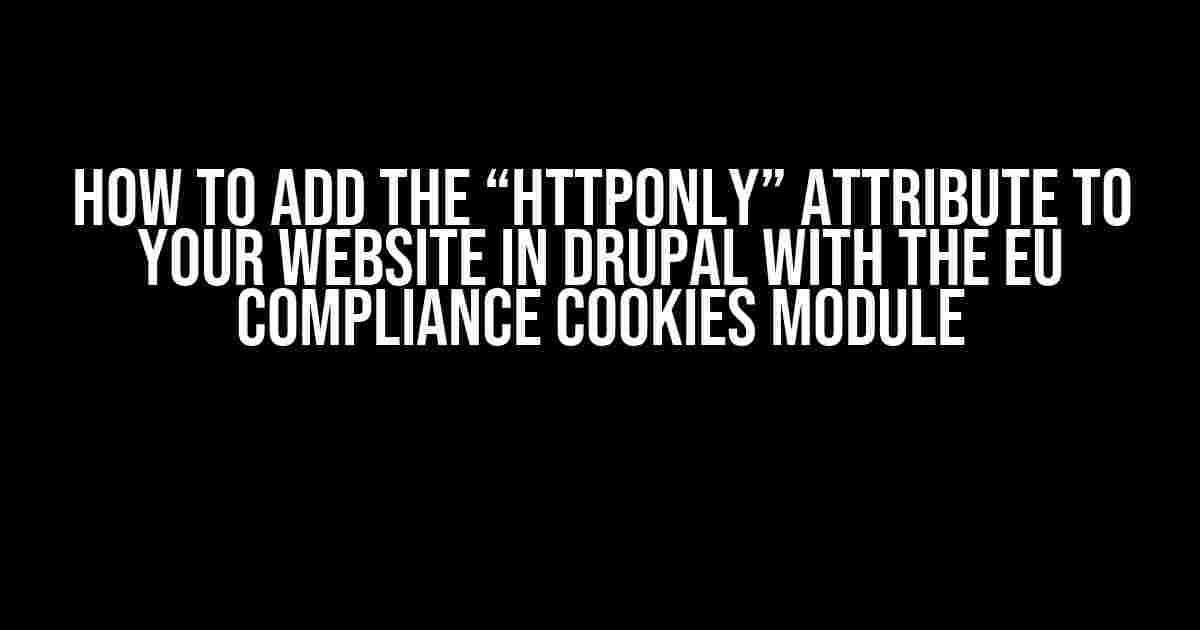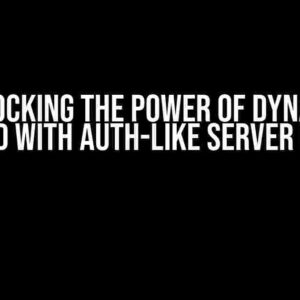Are you struggling to meet the EU’s cookie compliance requirements for your Drupal website? One crucial aspect of compliance is setting the “httponly” attribute for cookies. In this comprehensive guide, we’ll walk you through the steps to add the “httponly” attribute to your website using the EU Compliance Cookies module.
Why Do You Need the “httponly” Attribute?
The “httponly” attribute is a security feature that helps protect your website’s cookies from being accessed by malicious scripts. It ensures that cookies are only transmitted over HTTPS, making it more difficult for hackers to intercept and exploit sensitive information. In the EU, this attribute is a requirement for compliance with the General Data Protection Regulation (GDPR) and the ePrivacy Directive.
What is the EU Compliance Cookies Module?
The EU Compliance Cookies module is a popular Drupal module that helps websites comply with EU cookie regulations. It provides a range of features, including cookie consent management, cookie categorization, and compliance reporting. In this article, we’ll focus on using the module to add the “httponly” attribute to your website’s cookies.
Installing and Configuring the EU Compliance Cookies Module
Before we dive into adding the “httponly” attribute, make sure you have the EU Compliance Cookies module installed and configured on your Drupal website. Follow these steps:
- Go to your Drupal website’s administration page and navigate to the “Modules” section.
- Click on the “Install new module” button and enter the module’s name, “EU Compliance Cookies,” in the search bar.
- Click on the module’s name to open its details page, then click the “Install” button.
- Once installed, navigate to the “Configuration” section and click on the “EU Compliance Cookies” link.
- Configure the module according to your website’s requirements, including setting up cookie categories and consent settings.
Adding the “httponly” Attribute to Your Website’s Cookies
Now that you have the EU Compliance Cookies module installed and configured, it’s time to add the “httponly” attribute to your website’s cookies. Follow these steps:
Step 1: Enable the “httponly” Attribute in the EU Compliance Cookies Module
Navigate to the EU Compliance Cookies module’s configuration page and scroll down to the “Cookie settings” section. Check the box labeled “Set the ‘httponly’ flag on cookies” to enable the attribute.
<input type="checkbox" id="eu_cc_cookies_httponly" name="eu_cc_cookies[httponly]" value="1"> Set the 'httponly' flag on cookiesStep 2: Configure the Cookie Settings
In the same “Cookie settings” section, configure the cookie settings to include the “httponly” attribute. You can do this by adding the following code to the “Cookie settings” text area:
httponly = 1
secure = 1
samesite = laxThis code sets the “httponly” attribute to “1” (enabled), sets the “secure” attribute to “1” (HTTPS only), and sets the “samesite” attribute to “lax” (prevents cross-site requests).
Step 3: Clear Your Website’s Cache
After configuring the cookie settings, clear your website’s cache to ensure the changes take effect. You can do this by navigating to the “Configuration” section and clicking on the “Performance” link. Then, click the “Clear all caches” button.
Verifying the “httponly” Attribute
To verify that the “httponly” attribute has been added to your website’s cookies, follow these steps:
Step 1: Inspect Your Website’s Cookies
Open a web browser and navigate to your website. Open the browser’s developer tools by pressing F12 (Windows) or Command + Option + I (Mac). Switch to the “Application” or “Storage” tab and click on the “Cookies” section.
| Cookie Name | Value | HttpOnly |
|---|---|---|
| cookie_example | cookie_value | true |
In the cookies list, look for the “HttpOnly” column. If the “httponly” attribute has been successfully added, the value should be “true.”
Step 2: Check Your Website’s HTTP Headers
Another way to verify the “httponly” attribute is to check your website’s HTTP headers. You can do this using online tools like Redbot or HTTP Header Checker. Look for the “Set-Cookie” header in the response headers:
Set-Cookie: cookie_example=cookie_value; HttpOnly; Secure; SameSite=LaxIf the “HttpOnly” attribute is present in the “Set-Cookie” header, it indicates that the attribute has been successfully added to your website’s cookies.
Conclusion
Adding the “httponly” attribute to your website’s cookies is a crucial step in meeting the EU’s cookie compliance requirements. By following the steps outlined in this article, you can ensure that your Drupal website is compliant with the GDPR and the ePrivacy Directive. Remember to regularly review and update your cookie settings to ensure ongoing compliance.
If you have any questions or need further assistance, feel free to ask in the comments section below.
Additional Resources
For more information on the EU Compliance Cookies module and cookie compliance in general, check out these additional resources:
- EU Compliance Cookies module documentation: https://www.drupal.org/project/eu_cookies
- GDPR and ePrivacy Directive guidelines: https://gdpr.eu/
- Cookies and consent: https://cookiepedia.co.uk/cookie-consent
Stay compliant, and happy coding!
Frequently Asked Question
Get answers to your burning questions about adding the “httponly” attribute to your website with the EU Compliance Cookies module in Drupal!
How do I enable the EU Compliance Cookies module in Drupal?
To enable the EU Compliance Cookies module, simply go to your Drupal admin dashboard, navigate to the “Modules” section, and click on the “Enable” button next to the “EU Compliance Cookies” module. Once enabled, you’ll be able to configure the module to add the “httponly” attribute to your cookies.
Where do I find the EU Compliance Cookies module settings in Drupal?
To access the EU Compliance Cookies module settings, go to your Drupal admin dashboard and navigate to “Configuration” > “EU Compliance Cookies”. This is where you’ll find the settings to configure the module, including the option to add the “httponly” attribute to your cookies.
How do I add the “httponly” attribute to my cookies using the EU Compliance Cookies module?
To add the “httponly” attribute to your cookies, go to the EU Compliance Cookies module settings and click on the “Cookie settings” tab. Then, scroll down to the “Advanced” section and toggle the switch next to “Enable HttpOnly” to enable the attribute. Save your changes and you’re done!
What does the “httponly” attribute do for my website’s cookies?
The “httponly” attribute is a security feature that helps protect your website’s cookies from being accessed by client-side scripts, such as JavaScript. By adding this attribute, you can help prevent cross-site scripting (XSS) attacks and keep your users’ data more secure.
Is adding the “httponly” attribute to my cookies required for GDPR compliance?
While adding the “httponly” attribute is not strictly required for GDPR compliance, it’s a recommended best practice for securing sensitive user data. By taking this extra step, you can demonstrate your commitment to protecting user data and complying with GDPR regulations.



